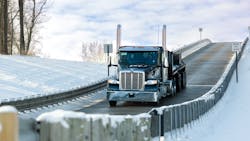Peterbilt to offer 18-speed transmission for extreme vocations
MARSHALL, Michigan—At its highest, the temperature hit about 10 degrees Fahrenheit one late-January morning at the freshly snow-covered Eaton proving grounds. A small group of trucking industry journalists gathered some 100 miles east of Detroit here to test drive Peterbilt 567, 389, and 579 models equipped with Paccar’s latest TX-18 and TX-18 Pro transmission offerings.
Before getting into the trucks and putting the new transmissions to work, Kyle Crawford, Peterbilt’s vocational marketing manager, asked members of the trade press to think about driving up the Eisenhower Memorial Tunnel in Denver hauling 140,000 lb. up an 8% to 10% grade. The tunnel, about 60 miles west of Denver on Interstate 70, runs through the Continental Divide at an average elevation of 11,112 ft.
See also: Paccar shows how trucking technology can make the world a better place
“Imagine going up and then you hit a traffic jam on an 8% grade, and someone pulls up behind you about one foot off and you think, ‘How am I going to keep from creeping back here,’” Crawford said. “This transmission has uphill assist. It has an urge to move so if you take your foot off the brake, it will start creeping forward with 140,000 lb. That is a huge perk for driver comfort."
“Then once you start going and you get out of traffic, it’s going to select the best gear,” Crawford continued. “It knows the angle, the grade you’re at, and calculates how much load you have on your truck. It’s going to select the best gear to make sure that you’re maintaining your speed as much as possible. It will upshift when it sees that you can go faster.”
The test track at Eaton’s proving grounds has both an 8% grade and a 15% grade, where a driver could feel firsthand how the transmission’s downshift works with Paccar’s MX-13 engine shift the way Crawford described.“Without this transmission, you’re in a manual transmission and trying to shift back, you’re going to be worn out at the end of the day and will likely make mistakes,” Crawford said. “Think about the drivers today. This is starting to allow us to transition more people into a truck so anyone with a CDL can get in and easily drive to expand that driver pool.”
On Feb. 15, Paccar officially announced the addition of its latest TX-18 and TX-18 Pro automated transmissions, available for Peterbilt 567, 579, and 389 models. The TX-18 offerings are new to Paccar’s transmission portfolio, which also includes the TX-8 automatic transmission and the TX-12 automated manual transmission.The new transmissions are also available with Kenworth models T680, T880 and W990 equipped with the Paccar MX-13 and MX-11 engines.
So, why now?
The TX-18 offerings are for more extreme vocational applications that the TX-12 transmission might not be ideal for, specifically for applications that haul more than 110,000 lb. fully loaded.
“If you get to more high performance on the highway or spend time going up through the Rockies or Appalachians, and you’re constantly pushing on that 110,000 lb., you’re going to want to start looking into the TX-18 transmission,” Crawford said.
The TX-18 will begin production in July 2022. The transmission will be calibrated by Paccar and manufactured by Eaton.
The TX-18 is designed to work exclusively with the Paccar MX-11 and MX-13 engines and for a variety of vocational applications, including heavy haul, dump truck, and cranes. The combination of the TX-18 transmission and the MX engine provides up to 1,850 lb. ft of torque and is rated up to 140,000 lb. GCWR.
Comparing the TX-18 and the TX-18 Pro
The TX-18 has low-speed maneuverability with small, even gear steps through all 18 forward speeds. A high-speed reverse with up to six configurable speeds is available in the TX-18 Pro to increase productivity in demanding applications. Both options have an automotive-style, stalk-mounted shifter that includes drive, neutral, reverse, and manual modes.Crawford pointed out that the TX-18 is geared toward basic on-highway high performance and can be used for more mild vocational applications. On the other hand, the TX-18 Pro is for on- and off-highway high-performance vocational applications, such as logging, oil field, and mining. Those applications likely would rely more on the Pro’s six reverse gears, extreme-duty clutch, and overall off-highway performance.
See also: Tour the Paccar Innovation Center in Silicon Valley
For example, a dump truck delivering a service on a zero-lane service road where there is no turnaround and the driver would have to reverse for a couple miles to get back to their load point would benefit from the TX-18 Pro’s six reverse gears.
“With a typical transmission you’re probably going to be maxed out at around 5 mph in reverse—depending on how your gears are set up, maybe even less,” Crawford advised. “When getting ready to back up and get your next load, you’re really limited by how comfortable you are driving in reverse."
“With the six gears, you are more comfortable doing 10 mph in reverse compared to 5 mph in reverse with a traditional transmission,” he added. “You’re saving time reversing back to your pickup point because of the reverse gears, adding productivity and uptime while doing the job that day.”
Features
Both transmission variants feature a high-pressure diecast aluminum casing, one-piece serviceable input shaft, helical gearing, precision lubrication system, extreme-duty clutch, and an integrated clutch housing. The transmission can be configured with an optional transmission cooler to help keep it operating efficiently in more demanding workloads. Both variants feature four application-specific calibrations and come standard with two power takeoff (PTO) openings capable of a combined 160 hp.Crawford noted that the TX-18 and TX-18 Pro are the most efficient vocational transmissions in terms of fuel economy, combining many of Paccar engineers’ lessons learned over the years.
The integrated Paccar powertrain provides a 47% reduction in parasitic losses and is 225 lb. lighter than Eaton's UltraShift, the current vocational AMT. The powertrain also works with predictive cruise control, which is another fuel economy enabler, Crawford explained.
The transmissions also include various features to drive uptime. The extreme-duty clutch is maintenance-free, Crawford explained, and by integrating the clutch housing, there are fewer chances for something to go wrong. The oil temperature sensor and pressure sensor are also integrated for ease of maintenance.
“Another big area in general for vocational applications going through rocks and with mud flying everywhere is things can clip wires,” Crawford pointed out. “So, to add protection, this has all internal wiring and sensors, so nothing will be kicked up that will cause any issues.
When it comes to productivity, the transmission has four application-specific calibrations. Peterbilt will collect the data from the fleet customer when they order to determine how they plan to use the truck and the specific transmission calibration for their duty cycles.
Both transmission variants also come standard with dual PTO (one on the back of the transmission and one on the bottom) for different needs and different setups.
“The TX-18 offers mobile PTO so you can operate the PTO while driving,” Crawford said. “A rock spreader application would use the mobile PTO, so dump trucks dumping their load and spreading it out.”
In terms of driver comfort and safety, the new transmissions have small, even gear steps for smooth transitions.
“The last thing a driver wants is to be going up a mountain and get to a point where there is a big gap between the next gear,” Crawford said. “And they start to lose their power while they are going up the hill and struggle to get their speed back up.”
The transmission’s next-generation controls allow it to predict based on what the incline is and what the load is to get the truck in the right gear going up or down the hill.
These transmissions will eventually replace the Eaton UltraShift, which will be phased out at some point moving forward, according to Crawford.
About the Author

Cristina Commendatore
Cristina Commendatore is a past FleetOwner editor-in-chief. She wrote for the publication from 2015 to 2023.




